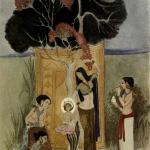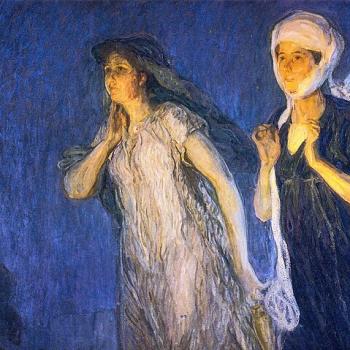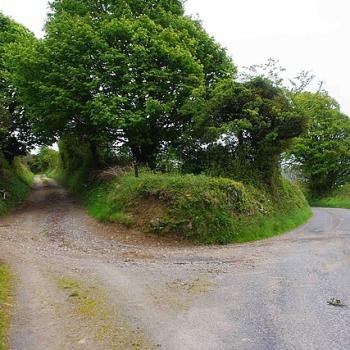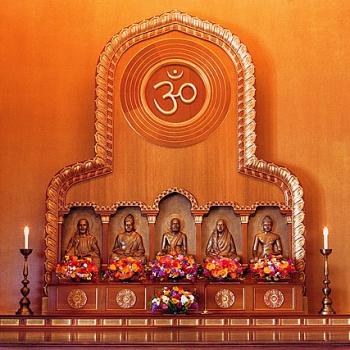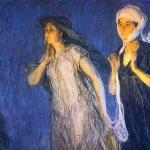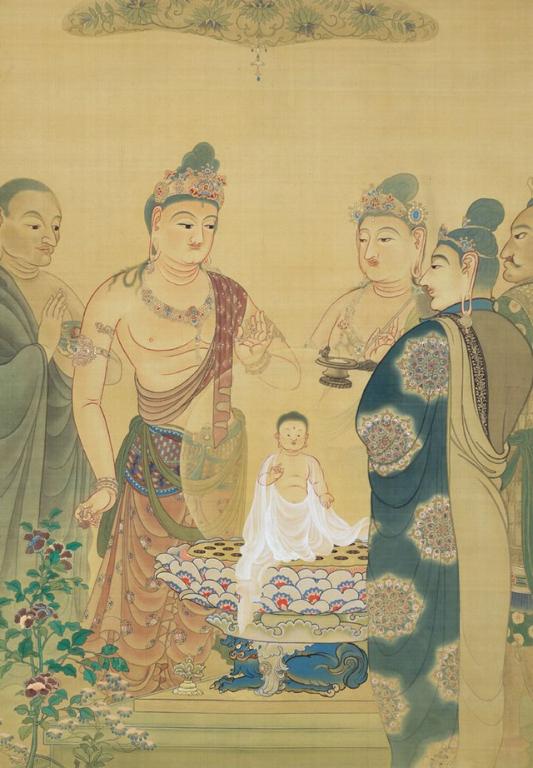
Shimomura Kanzan
1896
The master Nanyang Huizhong called to his attendant three times. And each time his attendant responded. The master said, “I was about to say I was ungrateful to you. But, you are ungrateful to me.”
Gateless Gate, case 17
According to the Buddhist lunar calendar observed in most of Asia, the Buddha’s birth will be observed this year in the middle of May. However, in the late 19th century, the Japanese officially adopted the Gregorian calendar. It was perhaps unintended but it became a genuine gift for many of us who struggle with consulting tables to track holidays floating through a lunar calendar. With that many of us in the West, and particular anyone following a Buddhist school rooted in Japan, the Buddha’s birth is always celebrated on April 8th.
The Japanese call it both the Kambutsu-e, or “Nativity festival,” and more often Hana Matsuri, the “flower festival.” In many Zen centers here it’s a family affair. For children it’s often the most memorable part of attending Buddhist religious festivals, being able to pour sweet tea over a small image of a child Buddha standing in a shallow bowl. You might picture the statue. He’s chubby and stands with one arm reaching down with a finger pointing to the earth and the other arm stretching up with a finger pointing to the heavens. The ceremony came from China to Japan at the beginning of the seventh century and has since been passed on to the West.
I think of that baby Buddha, and I find myself reflecting on the koan of the National Teacher and those three calls. I’ll come to that and why, but first some other thoughts.
The Sixth Ancestor in Zen’s long mythical history now turning into history, Huineng, had five dharma successors. One of them was Nanyang Huizhong. He was born in the year 675 and died a hundred years later. At least those are our traditional dates. Often long lives are pious embellishments in hagiographies. In this case Robert Aitken suggests he had to have been at least in his nineties when he died. So, in this case genuinely a long life.
After completing his formal training with Huineng he retreated to the countryside and tried to live in obscurity. With some success, he lasted there for forty years. But then he was called by imperial invitation to the capital. You can read order here, when an emperor invites, you are generally wise to accept. He spent many years there and would be treated as a personal teacher by two emperors. He was actually given the official title “Teacher of two Emperors” during his lifetime. After he died, Huizhong was given the title National Teacher. While there have been several National Teachers, when we hear the title without a specific name, it always means Nanyang Huizhong.
We don’t have life dates for his attendant, Danyun Yingzhen. We do know he was Huizhong’s sole heir. And we know their Zen lineage died with Danyun. Although both very much continue to guide those of us who walk the koan way. Huizhong appears here in the Gateless Gate, and twice in both the Blue Cliff Record and the Book of Equanimity, three of the classic koan anthologies. While Danyun appears in two koans.
Some commentators on this koan observe how the relationship between a teacher and a student can be fraught. And we can see how this might catch one’s attention from a surface read of the dialogue. But not without merit. One comment I ran across found an analogue for how complex this relationship might be by citing the Buddha’s relationship with his attendant Ananda.
Ananda, the Buddha’s cousin, was his faithful attendant for most of the Buddha’s teaching life. He is also renowned for his prodigious memory. Ananda is the legendary source of the recorded sayings and doings of Gautama Siddhartha. Which he was called upon to recite before the gathered monastics after the master died. For a consideration of the relationship between teacher and student, he didn’t have his own awakening under the guidance of the Buddha. It would come later, after the Buddha’s death, just ahead of that first great council.
So, yes. One can see many complexities for the teacher as well as the student. For the student, first to find their own way. To see into the matter deeply. To understand for themselves. It speaks to a sense of personal quest bound up with that relationship. Which over time is certainly wrapped up with other feelings. Wanting to please. Probably resenting failures of various sorts on the part of the teacher. Many things mixed up together.
And for the teacher, as well. We like to make the teacher a perfect mirror to the student, a perfect master. We can do this especially if the teacher is long dead, and complexities of personality are shall we say polished. For both good and ill, our culture and our time tends to notice failure. Our shadows are on full display. And what gets mixed in for us as students, is figuring out where the line is when a teacher’s shortcomings or worse become genuinely problematic. How that line might be different for different people only adds to the complexities.
A worthy consideration. And worth a moment. Maybe more.
But it isn’t what we’re really being invited into with this case. Here we have an exchange, those three calls. And then we have that enigmatic comment. Two points.
So, first the calls. Three, of course, is a magic number. Beloved and used in folklore and religion. And not just the really large Christian Trinity or Buddhism’s Trikaya. But they live in our mythic imagination in smaller but sometimes very important ways. For instance, three guesses, three wishes, and even, well, three bears. Here, three calls. Three is some kind of perfect number.
And, importantly, here, we get three responses. Their own kind of perfect number.
Attendant! Yes! Attendant! Yes! Attendant! Yes!
Aitken Roshi points out that as the attendant was a mature practitioner each response was as fresh as the first. Which reminds me of one of those early brain wave studies of meditators. It was an attempt to compare yogic practice and Zen. The yogi was set to meditate, using a mantra. She was wired up. And then from behind at random moments a bell was sounded. Each time the biofeedback monitor showed no reaction. The yogi was one with the mantra. However, when the bell sounded for the biofeedback wired up Zen practitioner, each time there was a full startle response. And there was no diminution over time. Each bell strike was met with a full response.
Attendant! Yes! Attendant! Yes! Attendant! Yes!
(At least as I like to tell this anecdote. Jan seems to think I’ve garbled the story over time. I guess that has its own lessons for the wise…)
For me the three calls are each like that proverbial box and its lid. A perfect match. A perfect fit. Not precisely one. But certainly not two.
Then there’s the gratitude thing. Here we move into particularly deep waters. Instead of ingratitude, another translation says, “standing with my back to you.” I find that image interesting. Of course, anyone who has been investigating the koan way for any time quickly notices that abuse is often in fact praise. So, ingratitude isn’t a bad way to go when speaking of something where words begin to fail. This reversal of the ordinary, using abuse as praise is another of those pointers. Those invitations we encounter on the Zen way. Things are just as they are, and sometimes they deserve a little closer look.
Here’s where I find the connection to the Buddha’s birthday. It’s not a reach to hear those words about “I thought I was ungrateful and now I see you’re ungrateful,” and hear the words attributed to the Buddha himself on the day of his birth. In that dream time, at his birth he stands and takes seven steps in each of the cardinal directions. Then he points one hand upwards and the other down, declaring “Beneath the heavens, above the earth, I alone am the holy one.”
For me in the midst of all this I recall a comment on Huizhong’s call of ingratitude from my koan teacher John Tarrant. “I thought I was alone in the universe. And now I see you, too, are also alone in the universe.”
It’s a powerful observation. On one hand a straight-forward pointing into the true deep. Where each of us is the center of the unfolding universe. And, of course, this line also exposes one of the shadows of our way, where seeing for ourselves can occasionally blind us to the fact there are many, many other centers to the great mess.
No doubt the odd traveler on the intimate way will succumb to Narcissus’s madness and perhaps share his fate. I’ve seen some advanced Zen practitioners flirt with this demon, noticing they have plumbed the depth, but missing something. It’s noticing the other at the same solitary place that explodes the danger and invites us all along.
Toward something truly worth noticing.
Robert Aitken once commented on the conclusion of the Fox koan, where there’s a lovely and strange encounter between the teacher Baizhang and his student Huangbo. The roshi observes how Baizhang thought he was alone in the universe, but there he saw that Huangbo too is alone in the universe. Lots of centers in this universe, the great mess.
My first successor Melissa Blacker offered her comment on this comment, “I’ve always assumed it was a reference to Shakyumuni’s words, ‘In heaven above and earth below, I’m the only one.’” And she concludes, “It has a deep meaning for me, expressing that our heart/minds are the same.” I can only add, for me, too.
And for you, as well.
This. Just this. Dangerous. Powerful. And all of it an invitation.
Don’t forget the meeting. Attendant! Yes! And the summary, we are each discovered within the great play of the mystery unfolding. Just this. Just you. Just me. Ordinary. And, well, quite extraordinary.
So, what to do with all this?
As it happens Nanyang Huizhong and Danyun Yingzhen appear in one more case together. It’s repeated as case 18 in the Blue Cliff Record and case 85 in the Book of Serenity.
The Emperor Suzong asked the National Teacher, “What would you like from me when you die?” Nanyang replied, “Build me a seamless tomb.” The emperor said, “Please give me the tomb’s design.” The master sat quietly for a time, and then said, “Do you understand?” The emperor said, no. I do not. The National Teacher responded, “When the time comes, go to my successor Danyun. And ask him.” After the National Teacher died the emperor sent for Danyun and told him about the encounter. Danyun replied with a verse:
South of Xiang, north of Tan
There is gold that fills the land.
Beneath a shadowless tree,
A ferry.
In the crystal palace there is no one who knows.
Here it all comes together. Master and disciple are totally different. And in the very same heartbeat, they’re one. The seamless tomb and the building are not two.
In this world, there is a great treasure. It is a rich vein that runs through you and me. Find that shadowless tree. Discover the silence that the National Teacher presented to the emperor. With that a center of the universe appears, a tree with no shadow.
Within the dream world you will discover that it is also a boat. The great ferry that carries each of us to a farther shore.
All this, those calls and that talk of ingratitude takes us to our true home. Which is no place other than here, a fire cast upon the world. Always, it’s here, smoldering, coals everywhere waiting to ignite into flame. Shifting images show it is a meeting of all the centers of the universe. With another shift it is a gathering of the birds of heaven. Another shift and it’s a palace of many rooms.
The true intimacy.
Our common inheritance.



